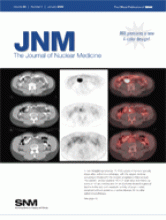TO THE EDITOR: Regarding the article by Scheer et al. in the June 2008 issue (1), I checked the percentage increase numbers in Table 2 and found them to be wrong. I assume the difference is due to what the authors call “average increase in SUVmax,” which implies that they averaged the maximum standardized uptake values (SUVs) from multiple lesions. Why could they not just use the average of the already averaged maximum SUVs? See my table (Table 1), based on their numbers.
Recalculation of Data from Table 2 of Scheer et al.
More important, they excluded a patient from the surgical group who had a −25% change in SUV and a patient from group B who had a 37% change in SUV because of the potential for measurement error due to necrosis (suggested by an SUV >10). Was necrosis, in fact, seen on CT? If not, why exclude these patients? Excluding them skews the numbers in favor of the point of the article. Why not exclude the patients who had SUVs greater than10 at follow-up if necrosis interfered with SUV measurement? If one does that with the group A numbers, the average increase in maximum SUV is 2%, obviously not significant. Also, patient 9 in group A was excluded, supposedly because the majority of the metastases had SUVs greater than 10. However, the average SUV was 9.9. Why not look at the lesions with SUVs less than 10? Is it simply a coincidence that that patient showed no change in SUV, a finding that did not support the authors' conclusion? Is it also a coincidence that the patient in group B who had the largest increase in SUV was excluded because a new adjacent metastasis prevented the authors from measuring SUV? Could they not have separated these reasonably well with the CT localization? Also, is not the development of a new metastasis even more significant than an increase in the SUV of existing disease?
Primary tumors may well suppress metastatic disease, and it is important for readers to know that metastases may increase activity after resection of a primary tumor. However, we need better science to support that conclusion.
Footnotes
-
COPYRIGHT © 2009 by the Society of Nuclear Medicine, Inc.
References
- 1.↵







